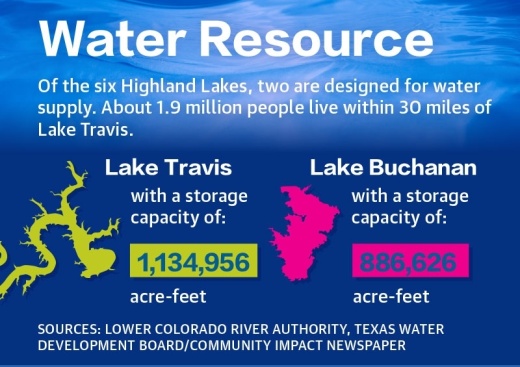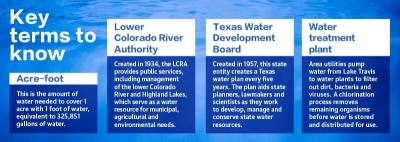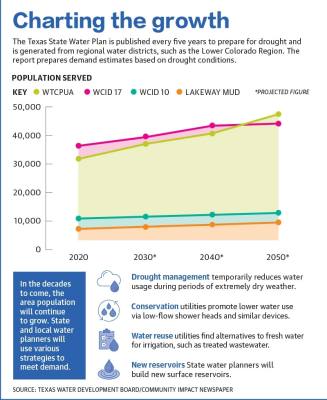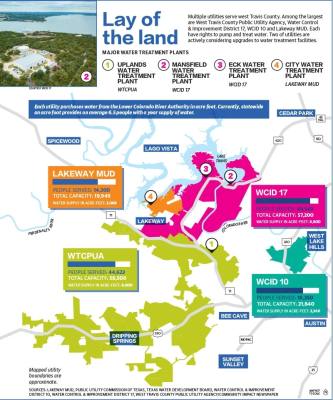These districts must manage future growth in commercial and residential demand for water in areas of Travis and Hays counties that are quickly urbanizing and sit above stressed groundwater sources while also controlling costs that impact current water customers, said Walt Smith, a Hays County Commissioner who also sits on the WTCPUA board.
“You want to try to minimize the impact on current ratepayers while providing service throughout our service territory,” he said.
For WTCPUA, a public hearing will be held Aug. 19 to discuss capital expenditures, including $66.7 million in proposed water treatment and water line improvements to meet demand over the next 10 years for growth–particularly south of Bee Cave toward Dripping Springs. These projects are in addition to the $39.5 million already budgeted in its 2018 capital improvement budget.
The growth the district faces is illustrated by a reported 16,000 homes that have been approved for construction near Dripping Springs and are yet to be built, Smith said.
“They have a choice with those 16,000 homes,” Smith said. “They can go get groundwater resources out of Hays County, and we have wells going dry in western Hays County right now, or we as the wholesale provider can build out infrastructure to get to those homes.”
Capital investment needs
Currently, among its largest capital efforts, is WTCPUA’s $27 million proposed expansion of its only water treatment plant, the Uplands plant, according to a CIP report released by the WTCPUA in July.
The WTCPUA report indicates the extra capacity is needed to meet an estimated 74% growth in the number of service connections that will take place in the next 10 years. Much of this will come from Dripping Springs along areas near US 290, RR 1826, Fitzhugh Lane and along Nutty Brown Road, where there are also plans to build a HEB grocery store. In these areas, WTCPUA could see an estimated additional 4.68 million gallons per day of demand over the next 10 years, or enough water to serve an additional 15,600 households.
To meet this 10-year growth projection and other growth in other areas closer to Bee Cave, WTCPUA board members will consider expansion in the next few years of its Uplands water treatment plant from its current 20 million gallon per day capacity to 33 million gallons per day.
WTCPUA General Manager Jennifer Riechers said expansion is also needed to take pressure off the existing equipment that each night must resupply WTCPUA area water towers with potable water.
“We have huge pumps that are running, and they are not designed to run 24 hours per day,” she said.
Infrastructure decisions totaling millions of dollars are currently underway by a mix of other municipal utility districts and public water utilities in West Travis County. These utilities also are currently forming their own capital improvement budgets funded by a combination of water rates and property tax assessments.
A state water plan, approved in July by the Texas Water Development Board to prepare Texas for drought, states local utilities expect water demand and the populations they serve to grow steadily.
Similar to WTCPUA, population growth is also coming to WCID 17, which serves neighborhoods northeast and west of Lakeway. Water demand in the district during a peak drought could grow 20% over the next 30-years–on pace with the growth in the number of people it serves, according to the state water plan.
Unlike WTCPUA, growth in WCID 17 is tempered by the limited land available for development, said WCID 17 General Manager Jason Homan.
Roughly 18% of the land mass in the WCID’s service area has open acreage. Most of this is, near Flintrock, Serene Hills, the Cardinal Hills neighborhood and a few isolated pockets near Hudson Bend, Homan said.
“We are anticipating the majority of the lots to come in at density, which means condos, apartment buildings and homes that are not single-family properties. Now, of course, that is subject to city approval. But we look at the patterns going on right now, and try to anticipate based on the highest-use scenario.”
To prepare, WCID 17 could spend as much as $11.30 million to increase the capacity of its Mansfield water treatment plant from 6 million gallons per day to as much as 12 million gallons per day. How the project is funded and phased will be decided at its August board meeting, Homan said.
WCID 17 designed the plant from its first construction knowing the expansion would be needed, he said. WCID 17 staff also has a second water treatment plant, Eck, that can treat 16 million gallons per day, and there are no plans at this time to expand the Eck facility, Homan said.
In Water Control & Improvement District 10, which serves drinking water via water purchases from the city of Austin to about 7,600 people in and near the city of West Lake Hills, water planners have implemented $45.97 million in capital projects to extend and expand water lines.
State water planning
West Travis County is part of the Lower Colorado Regional Planning Area, according to The Texas Water Development Board’s state water plan. It is a 14-county area that stretches from Mills County in the north to Matagorda County on the Texas coast and includes the Austin metro area bounded by Travis and Hays counties. The Colorado River flows through this area, and dams along its course create the Highland Lakes, including lakes Buchanan, Travis and Austin, which function as major sources of potable drinking water.
Area water utilities purchase raw water from the Lower Colorado River Authority using contracts measured in acre feet of water. An acre foot equals 325,851 gallons, and on average statewide, this supplies about 6 people water for one year.
For example, WCID 17 can purchase up to 8,800 acre feet from the LCRA, Homan said. WTCPUA has a contract to purchase up to 9,000 acre feet, and WCID 10 purchases up to 3,360 acre feet from the city of Austin.
To meet growing demand for water from these utilities as well as supply water for important uses such as power generation and irrigation, the LCRA at a cost of $315 million, has added an additional reservoir near the Texas coast, the Arbuckle Reservoir. The reservoir is intended to reduce water demand on the Highland Lakes. And, according to the state water plan, more reservoirs will be needed beyond 2030. The LCRA is considering adding these in its long-term plans, and according to the LCRA, plans to spend $59.4 million in the next five years on water supply projects.
However, raw water purchases alone will not meet the coming needs of growth, according to the state water plan. Local utility planners are also spending time now to plan for droughts, encourage conservation, find water line leaks and set up other strategies, like the use of treated wastewater for irrigation.
Utilities also charge water customers based on usage. The more water a customer uses, the higher the water rate; however, escalating water rates currently has limited effect on water demand, said Riechers.
“Our rates are designed for conservation,” Riechers said. “The more water you use, the higher the rates go, but around here people are not so much affected by that. They are willing to pay that water bill.”








